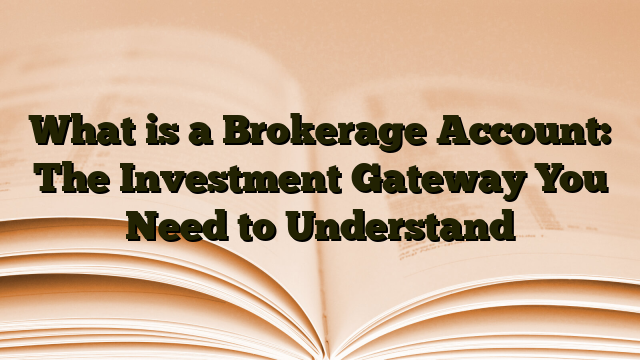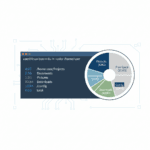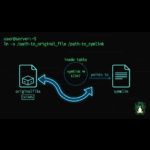I spent my first six months investing without really understanding what a brokerage account was. I knew I needed one to buy stocks, but that was about it. I didn’t understand how it differed from my 401k, what the tax implications were, or why I’d want one in addition to my retirement accounts.
That confusion cost me opportunities. I kept all my investing inside my IRA because I thought that’s what you’re “supposed” to do. Meanwhile, I was sitting on cash I could have been investing in a taxable brokerage account, letting it grow while keeping it accessible.
Let me break down exactly what a brokerage account is, when you need one, and how to use it without the financial jargon that makes this stuff unnecessarily complicated.
What a Brokerage Account Actually Is
A brokerage account is like a specialized bank account designed specifically for buying and selling investments. Just like you need a checking account to manage your everyday money, you need a brokerage account to hold stocks, bonds, ETFs, and mutual funds.
Here’s the key difference from a regular bank account: your money in a brokerage doesn’t just sit there. You use it to purchase investments that can grow in value over time. When you want to sell those investments, the proceeds go back into your brokerage account as cash.

Think of it as the middleman between your bank account and the stock market. You transfer money from your bank to your brokerage (usually takes 1-3 business days), then use that cash to buy whatever investments you want.
How Brokerage Accounts Differ From Retirement Accounts
This is where most beginners get confused, and honestly, it’s not intuitive at first. Both brokerage accounts and retirement accounts (like 401ks and IRAs) let you invest in stocks and funds. So what’s the difference?
Retirement accounts have tax advantages and restrictions:
- Contributions may be tax-deductible (traditional) or grow tax-free (Roth)
- Annual contribution limits ($7,000 for IRAs, $23,000 for 401ks in 2025)
- Penalties for withdrawing before age 59½
- Designed specifically for retirement savings
Brokerage accounts are flexible but taxed:
- No contribution limits – invest as much as you want
- Withdraw money anytime without penalties
- Pay taxes on dividends and capital gains each year
- Can be used for any financial goal, not just retirement
I learned this the hard way when I wanted to save for a down payment on a house. I had been dumping everything into my Roth IRA, thinking I was being responsible. Then I realized I couldn’t access that money easily without jumping through hoops. A brokerage account would have been the smarter move for that mid-term goal.
Understanding Roth IRA vs Traditional IRA differences helps clarify when retirement accounts make sense versus using a regular brokerage.
When You Should Use a Brokerage Account
Most beginners think brokerage accounts are only for rich people or serious traders. That’s completely wrong. Here are the scenarios where a brokerage account makes perfect sense:
After maxing out retirement contributions. If you’re already contributing the maximum to your 401k and IRA, a brokerage account is where your additional investments go. There are no contribution caps.
For goals before retirement. Saving for a house down payment in 10 years? Want to build wealth but might need access before age 59½? A brokerage account gives you that flexibility without early withdrawal penalties.
After building your emergency fund. Once you have 3-6 months of expenses saved in cash, extra money can go into a brokerage to start working for you instead of earning minimal interest.
When you want investment flexibility. Retirement accounts often limit what you can invest in. Brokerage accounts let you buy individual stocks, REITs, commodities, or any publicly traded security.
I opened my first brokerage account after I had my IRA contributions automated. It felt like leveling up – suddenly I wasn’t limited by contribution caps anymore.
The Tax Reality You Need to Understand
This is the part that makes brokerage accounts less attractive than retirement accounts, but it’s manageable once you understand how it works.
In a brokerage account, you pay taxes in two situations:
When you sell investments for a profit (capital gains): If you buy a stock for $1,000 and sell it for $1,500, you owe taxes on that $500 gain. The rate depends on how long you held it. Hold for less than a year, and it’s taxed as regular income (short-term capital gains). Hold for more than a year, and you get preferential long-term capital gains rates – typically 0%, 15%, or 20% depending on your income.
When you receive dividends or interest: Many stocks and funds pay dividends quarterly. These are taxable in the year you receive them, even if you reinvest them automatically.
Here’s where it gets interesting – you can also use losses to offset gains. If you lose $500 on one investment but gain $1,000 on another in the same year, you only owe taxes on the $500 net gain. This is called tax-loss harvesting, and it’s a legitimate strategy to reduce your tax bill.
Your brokerage will send you a Form 1099-B each February showing all your transactions for the previous year. You’ll use this to complete Schedule D on your tax return. It sounds complicated, but tax software like TurboTax imports this data automatically.
Types of Brokerage Accounts
Not all brokerage accounts work the same way. There are a few variations to be aware of:
Individual brokerage account: Just you as the account owner. Most common for single investors.
Joint brokerage account: Two or more owners, typically used by married couples. Both people have equal access to manage and withdraw funds.
Cash account: You can only trade with money you actually have in the account. This is what most beginners should start with – it prevents you from getting into trouble with borrowed money.
Margin account: Lets you borrow money from your broker to buy investments. Sounds appealing until you realize you’re paying interest and can lose more than you invested. I’d avoid margin until you really know what you’re doing.
I started with a cash account at Fidelity. Simple, straightforward, no risk of accidentally borrowing money and getting margin called.
How to Actually Open a Brokerage Account
Opening a brokerage account takes about 10-15 minutes online. Here’s the actual process:
Choose a brokerage. Fidelity, Schwab, and Vanguard are solid choices for beginners. They all offer commission-free stock and ETF trading, no account minimums, and strong customer support. Robinhood and Webull have simpler apps but fewer research tools and educational resources.
Look for these features:
- Zero commissions on stock and ETF trades
- No account maintenance fees
- Good mobile app and website
- Educational resources for beginners
- Responsive customer service
Complete the application. You’ll provide basic information – name, address, Social Security number, employment details, and bank account for transfers. They’ll ask about your investment experience and financial situation. Be honest – this helps them provide appropriate investment options.
Fund your account. Link your bank account and transfer money. Most brokers let you start with any amount, though you’ll need at least enough to buy one share of something or one share of an ETF.
Choose your investments. Now the account is open and funded, you can start buying. For beginners, investing in index funds is usually the smartest move – instant diversification with low fees.
According to NerdWallet’s brokerage account guide, most major brokers now offer fractional shares, meaning you can invest with as little as $1 in many cases.
The Biggest Brokerage Account Mistakes Beginners Make
I’ve made most of these mistakes myself. Learn from my expensive education:
Trading too frequently. Every time you sell something for a profit, you trigger a taxable event. In a brokerage account, excessive trading means excessive taxes. This isn’t a retirement account where trades are tax-deferred. Buy quality investments and hold them. The strategy of dollar cost averaging helps you invest consistently without the temptation to time the market.
Not considering tax efficiency. Some investments are more tax-friendly than others. Index funds that rarely sell holdings generate fewer taxable events than actively managed funds that trade constantly. Keep tax-inefficient investments (like bonds or REITs) in retirement accounts when possible, and tax-efficient investments (like index funds) in your brokerage.
Ignoring fees. While most brokers now offer commission-free trading, some still charge fees for mutual funds, options contracts, or account maintenance. Read the fee schedule before you sign up. A $4.95 trade fee might not sound like much, but if you’re investing small amounts regularly, those fees destroy your returns.
Investing before building emergency savings. I see beginners rush to open a brokerage and start investing without having cash reserves. The problem? When an emergency hits, you’re forced to sell investments at whatever the market price is – possibly at a loss. Build your emergency fund first.
Not reviewing statements. Your brokerage sends monthly or quarterly statements. Actually read them. Check for errors, unauthorized trades, or suspicious activity. According to FINRA, reviewing statements helps catch problems early before they become costly mistakes.
How a Brokerage Account Fits Your Overall Strategy
Here’s how I think about the priority order for where your money should go:
First, contribute enough to your 401k to get any employer match. That’s free money – don’t leave it on the table.
Second, save $1,000-$2,000 in a basic emergency fund. This covers small unexpected expenses without derailing everything.
Third, pay off high-interest debt. Anything over 7-8% interest should be eliminated before you start investing additional money.
Fourth, max out a Roth IRA if you’re eligible. Tax-free growth for retirement is incredibly valuable.
Fifth, build your full emergency fund. Get that up to 3-6 months of expenses in a high-yield savings account.
Finally, open a brokerage account for everything beyond that. This is where you invest for non-retirement goals, save beyond contribution limits, or build additional wealth.
Using the 50/30/20 budget rule can help you figure out how much you can realistically invest each month across all these priorities.
What to Do After Opening Your Account
You’ve opened the account and transferred money. Now what?
Don’t panic about making the “perfect” first investment. Start simple. Buy a broad market index fund like VTI (Vanguard Total Stock Market) or VOO (Vanguard S&P 500). These give you instant exposure to hundreds or thousands of companies with one purchase.
Set up automatic investments if possible. Most brokers let you schedule recurring transfers from your bank and automatic purchases of investments. This removes emotion from the equation and builds the habit of consistent investing.
Keep some cash in the account. You don’t have to invest every dollar immediately. Having 5-10% in cash gives you dry powder to take advantage of opportunities or market dips.
Resist the urge to check it constantly. I check my brokerage account maybe once a week now. When I started, I was logging in three times a day, watching every fluctuation. That’s exhausting and leads to emotional decisions.
The investments you make in your brokerage account should align with your timeline. Money you’ll need in 2-3 years? Keep it conservative or don’t invest it at all. Money you won’t need for 10+ years? You can tolerate more volatility with stocks.
The Bottom Line on Brokerage Accounts
A brokerage account is simply a tool that lets you invest money outside of retirement accounts. It offers flexibility and unlimited contributions but lacks the tax advantages of IRAs and 401ks.
You should open one after you’ve established emergency savings and are contributing to retirement accounts. Use it for mid-term goals, additional investing beyond retirement contribution limits, or building taxable wealth you can access anytime.
The taxes aren’t as scary as they sound. Yes, you’ll owe capital gains taxes when you sell for a profit, but long-term capital gains rates are quite reasonable. And the flexibility of accessing your money without penalties often outweighs the tax cost.
Choose a reputable broker with no commissions and no account fees. Fidelity, Schwab, and Vanguard are all excellent. Then start simple with index funds and build from there.
I wish someone had explained brokerage accounts to me this clearly when I started. I would have opened one years earlier and had more flexibility with my money. Now you know everything I learned the slow way.







